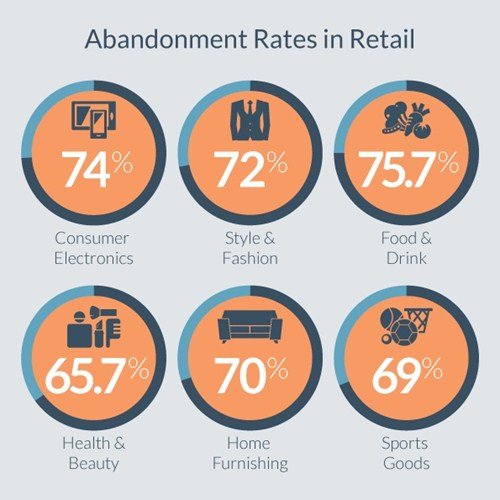3 marketing metrics retailers should be using
For 22 consecutive months UK retail sales have experienced year on year growth! Falling high street prices and increasing online sales mean that retailers need to understand how important speed of response is in order to stay competitive in today’s marketplace.
What KPI’s should you be using? Here are three key metrics you should be scrutinising to ensure that your marketing strategy is aligned to your business objectives:
- Online attribution
- Increase in mobile device use
- Shopping cart abandonment rates
Metric 1: Online attribution
Over 11% of the total UK retail sales figures per month is attributed to online sales. You might be driving sales online and meeting your revenue targets, but can you do even better?
The paid search programs of 240 major US and European retailers were evaluated in a Google / Forrester Consulting study. The findings suggested that there was an air of complacency amongst retail marketers, that their search campaigns were “good enough”. However, savvy marketers who take advantage of the real-time insights that call tracking provides are reaping the benefits of the considerable opportunities for growth in the sector.
Interactions with your brand across a mix of channels is now the norm in the consumer path to purchase. Accurate attribution is key to understanding how your customers enter the sales funnel and what drives them to the point of purchase. Once you understand how your campaigns, keywords and sources are performing, it’s easy to see where you need to allocate your ad spend to maximise your return on investment.
Attribution isn’t a difficult task. Call tracking technology enables you to see the effectiveness of your campaigns in real time – providing you with valuable conversion data instantly. This allows you to respond to changes in the market quickly and tweak your campaigns immediately to great effect.
Call tracking reveals insights about the relevant touch-points throughout the consumer journey that help you make smarter decisions about your marketing spend:
- Understand which marketing is working and optimise your media mix accordingly.
- Align offline and online channels and journeys and discover how the two feed off one another in the purchasing cycle.
- Experimenting with new channels to drive growth becomes less of a risk because it’s easy to attribute the value they bring to your overall campaign.
Metric 2: Increase in mobile device use
37% of online sales are made on a mobile device. In the last four years, mCommerce visits have grown by 2,000%.
Customers like to connect with brands. Mobile is not simply a sales channel but a larger part of the consumer journey, offering you a significant opportunity to connect and engage with customers in new and exciting ways. Shoppers are no longer tied to their desktops. Smartphones are used as personal shopping assistants both inside and outside shops, allowing customers to compare prices, read reviews, get the best deals – even call the store to check product details and availability.
So how well is your site converting mobile shoppers – and how are you measuring this?
The difference between mobile traffic and mobile conversions suggests that retail websites aren’t effectively optimised for mobile commerce. However, we know that there is a response gap. If a mobile visitor calls you, how do you know whether they converted or not?
Without call tracking in place, you miss out on a number of opportunities to lessen the discrepancy between online and offline. As mobile traffic increases, the disconnect increases too. Can you afford to miss out on the valuable intelligence that call tracking provides?
Metric 3: Shopping cart abandonment rates
63% of abandoned transactions are recoverable, according to estimates by BI Intelligence. Online retail shopping cart abandonment rates are a nuisance – but they also represent a huge opportunity.
With online sales and mobile use set to grow even further, the value of abandoned shopping carts will increase in turn.
The mistake is in seeing these as lost sales.
With the right tools in place, you can establish whether these transactions were really abandoned – or whether the customer simply hit a stumbling block and decided to complete the transaction offline instead. This enables you to put appropriate strategies in place for dealing with cart abandonments more proactively in future.
- Unearth the complexities of the relationship between consumer and retailer and discover why the phone is still so important to both.
- Capture missing offline response data and tie it back to online activity.
- Identify why customers drop out of the sales cycle, enabling you to rectify user experience problems.
In summary
Consumer-focused retailers are now investing in technology to collect and leverage data in order to improve customer experience and increase revenue.
Monitoring these three key metrics will provide you with the insights into consumer behaviour you need to embrace shifting trends, improve service and allow you to be much more responsive in your marketing efforts.




